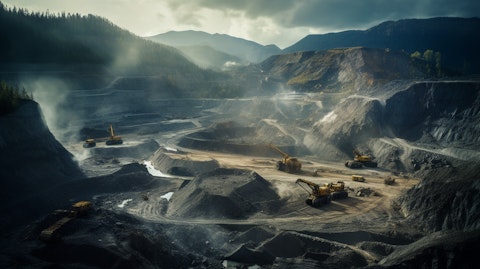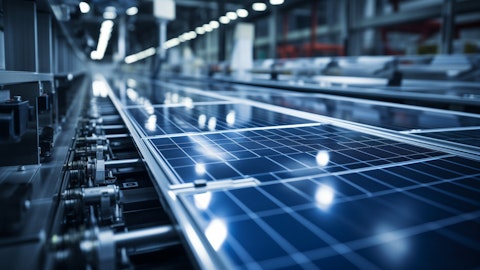Harmony Gold Mining Company Limited (NYSE:HMY) Q4 2025 Earnings Call Transcript August 28, 2025
Harmony Gold Mining Company Limited reports earnings inline with expectations. Reported EPS is $0.567 EPS, expectations were $0.567.
Beyers B. Nel: All right. Good morning, everybody, and thank you for joining us. I’m Beyers Nel, the CEO of Harmony. Today, we are presenting our financial year ’25 results that unpack not only our operational and financial performance, but it also details how we are creating value for our shareholders and all our stakeholders. You’ll also hear today from our Financial Director, Boipelo Lekubo, who will take you through the financial detail later on in the deck. Before we begin, please take note of our safe harbor statement. We encourage you to read the cautionary language in full. And with that, let’s move to the heart of the equity story. FY ’25 marks our 10th consecutive year of meeting production guidance. This level of consistency is rare in our sector and is underpinned by responsible stewardship, operational excellence, effective capital allocation and cash certainty.
Harmony has delivered a steady performance over the past decade, contributing to investor confidence and long-term trust. Our growth story is built on consistent delivery, higher-quality ore bodies, disciplined cost management, record cash flows and a robust balance sheet. It also sets the stage for a future powered by quality gold and meaningful copper. Our success has been built by keeping safety, sustainability and operational excellence as nonnegotiables. Copper, of course, provides a catalyst to our investment case through MAC Copper, Eva Copper and Wafi-Golpu. This will further enhance the portfolio and improve our quality across commodity cycles. Our success is built on trust and collaboration, and we remain focused on the needs and interests of all our stakeholders.

This commitment positions Harmony as a partner of choice where we operate. Harmony has once again delivered a stellar operating and financial set of results. Safety is our priority. And despite the devastating losses in the second half of the financial year, our LTIFR is trending lower. In fact, we have managed to achieve the lowest ever LTIFR in our history, evidence that the strategy is correct and that our safety culture is improving. We have generated record high cash flows with adjusted free cash flow reaching just over ZAR 11 billion at a 16% margin. Headline earnings per share rose by 25% (sic) [ 26% ] to ZAR 23.37 per share, and we will pay a record final dividend of ZAR 2.4 billion. We hit the upper end of production guidance at 46 tonnes of gold or about 1.48 million ounces and kept all-in sustaining costs in line with guidance at ZAR 1.05 million a kilogram or about USD 1,800 per ounce.
Our underground recovered grade guidance continues to increase. And at 6.27 grams per tonne, we exceeded the upward revised grade guidance as well. This performance is not a once-off. It reflects rather the structurally improved quality of our portfolio and the consistency and resilience in our operating model. Harmony has, for the second consecutive year, delivered record-breaking cash flows. While we have certainly been assisted by a record gold price, the main driver of our performance has been a combination of adding high-grade assets and investing in life of mine extension projects. We have delivered an unmatched performance with a 54% growth in adjusted free cash flow. This alongside cash is certainty, but also provides us with strategic optionality.
It derisks our capital program, supports a consistent dividend and positions us to fund our various projects and value-accretive acquisitions. At Harmony, everything begins with safety. We ensure that at all times, we take safety personally. While the first half of the financial year saw us deliver our best safety performance ever, the second half was simply unacceptable in the modern era of mining and the lessons learned have been taken on board and incorporated. Encouragingly, our LTIFR is trending in the right direction, and FY ’25 reached a company all-time low of 5.39 per million hours worked. One of our biggest risks is full of ground, where LTIFR has decreased by 25% over 5 years, even as we mine some of the world’s deepest, most technically demanding ore bodies.
Q&A Session
Follow Harmony Gold Mining Co Ltd (NYSE:HMY)
Follow Harmony Gold Mining Co Ltd (NYSE:HMY)
Receive real-time insider trading and news alerts
Our journey to zero harm continues, and it continues with urgency, with unity in Harmony and with unwavering resolve. In order to ensure we achieve our goal of zero harm, we have moved from lagging to leading indicators. We are seeing faster A- Hazard closure times, hard evidence that our system is working. High-risk work verification means that the all clear is earned, not assumed. And this is how we turn intent into outcomes and outcomes into culture. The message throughout Harmony is clear. A safe mine is a productive mine, and we will never trade safety for tonnes. Quality mining is imperative across all our operations. I believe we are consistently getting this right, which is evident in excellent grade control and stable, predictable production.
Underground recovered grades increased to 6.27 grams per tonne, driven by a phenomenal performance at Mponeng and a solid performance at Moab Khotsong as well. Despite the impact of safety stoppages and inclement weather in the second half, we still met the upper end of our guidance. In line with plan, group production decreased by 5% to 46 tonnes or 1.48 rather million ounces. Quality over volume is yielding results, and we mine smarter ounces and boost our resilience. All-in sustaining cost increases remain controlled and in line with guidance, rising 17% to ZAR 1.05 million a kilogram or about USD 1,800 per ounce. This reflects lower planned production, mine inflation, higher sustaining capital and royalties on stronger revenue. Because we are a rand cost producer, the stronger rand resulted in higher U.S. dollar reported cost.
Even so, our investment case in quality has moved us down the global cost curve. We have expanded group adjusted free cash flow margins eightfold over the past 4 years whilst investing to sustain and grow high-quality ounces. Harmony has maintained its predictable cash operating cost base. Over 90% of our operating costs are rand denominated. Total labor and electricity costs make up 72% of group costs. Wage inflation is predictable under our 5-year agreement and power tariffs are regulated. Royalties contribute about ZAR 41,000 a kilogram to cash operating costs on the back of improved revenues and profitability. As a result, total cash operating costs increased by 9%, and that is as planned. On a per unit basis, costs rose by 15% given lower production as discussed.
Our planning cycle and disciplined procurement keep cost outcomes within parameters, supporting margin resilience. This slide is very familiar, but it perfectly illustrates how we have transformed Harmony into a company with sustained higher margins. Through our various acquisitions and capital projects, the portfolio is now doing exactly what we designed it to do. High- grade SA underground and surface operations generate significant free cash with margins of 44% and 36%, respectively. Hidden Valley continues to deliver with margins at an exceptional 48%. Our optimized SA underground assets mine for cash at lower but positive margin, helping fund our growth and enabling us to extend mine lives responsibly. This portfolio balance is the engine behind record cash flow generation.
Our FY ’25 results reflect more than just numbers. They show our purpose in action. Sustainability is not an add-on. It’s embedded in our planning, how we mine and how we grow. Independent ratings confirm this progress with our inclusion in the FTSE4Good Index for the eighth consecutive year. The MSCI upgrading us to BB ahead of industry average. CDP scored as A- for water stewardship, and we conform with the SBTi for our global climate goals. These achievements reinforce our commitment to responsible mining and long-term value creation. Operational excellence is how we turn plans into results. The goal remains simple, safe, profitable production. We have built a quality portfolio that is resilient by design. We have divided our operations into 4 distinct quadrants, each with its own plan, risk profile and strategy.
This ensures we deliver as guided and extract the absolute best from our assets. Together, these quadrants give us stability and the capacity to reinvest into even higher quality ounces. Let’s look at the high-grade operations first. Mponeng once again delivered a phenomenal performance with an underground recovered grade of 11.27 grams per tonne. FY ’25 production from our high-grade mines increased by 8% to 16.5 tonnes, while grade improved by 10% to 9.89 grams per tonne. All-in sustaining costs increased by 9% to close to ZAR 860,000 a kilogram. These assets generated ZAR 8.8 billion in adjusted free cash flow at an excellent 35% margin. We are extending the life of these mines to around 20 years each with disciplined high-return projects.
Once these projects are complete, Moab Khotsong and Mponeng both with recovered grades of around 9 grams per tonne will each produce 200,000 to 250,000 ounces annually at steady state. Important to note is that we expect a dip in production at Moab Khotsong from 6 tonnes to 4 tonnes between 2027 and 2031. This gap arose largely as the Zaaiplaats feasibility study was only completed after Harmony acquired the asset. At both Moab and Mponeng, we experienced challenges in securing contractors to assist with our projects. At Moab, we’ve successfully mobilized our internal teams to keep the project moving and maintain momentum. At Mponeng, after the liquidation of the contractor, it took some time to renegotiate the commercial terms to ensure long-term value and execution certainty.
We have adjusted project sequencing to maintain progress and to minimize disruption. These actions are already yielding positive momentum. Further, we are progressing the very exciting 100-megawatt renewable solar plant at Moab Khotsong, which will reduce our reliability on Eskom and mitigate higher tariffs and energy inflation. Hidden Valley delivered another strong performance. In line with the plan, production remained steady at 5.1 tonnes at a recovered grade of 1.35 grams per tonne. All-in sustaining costs increased by 7% to ZAR 868,000 a kilogram. Free cash flow margins remained exceptional at 48% with ZAR 3.8 billion generated in adjusted free cash flow. CapEx remains focused on capitalized stripping, necessary fleet replacement and tailing storage facility development to sustain production.
FY ’26 priorities include life of mine extension studies beyond 2030 and the dewatering cyclone project to optimize TFS (sic) [ TSF ] deposition. Our South African surface operations remain a quiet powerhouse of low-risk and high-margin cash. Despite the heavy rainfall, which reduced production by 13% to 7.9 tonnes, margins stayed solid at 36%. As a result, all-in sustaining costs increased higher than planned to ZAR 853,000 a kilogram. We invested ZAR 1.4 billion on the projects at Mine Waste Solutions, which include the Kareerand TSF extension and the Mispah pump station to sustain and grow output. The Mine Waste Solutions extension project is largely complete and is delivering 100,000 ounces annually. We are improving flexibility and the mining mix at Mine Waste Solutions as well.
As a reminder, we have a further over 5.7 million ounces in resources in old tailings dam in the free state alone. Our optimized underground portfolio produced 16.5 tonnes at 4.58 grams per tonne. All-in sustaining costs increased by 26% to ZAR 1.4 million a kilogram due to lower volumes following necessary safety stoppages, while still delivering ZAR 2.3 billion in adjusted free cash flow. The role of these assets is clear, mine for cash safely and predictably with improved discipline and flexibility. The priority in FY ’26 is the Target 1 turnaround, which is now showing green shoots in terms of higher volumes and grades coming through. Our FY ’26 guidance reflects consistency and confidence in our planning. Our planning is, of course, aimed at ensuring that we have safe, sustainable operations with safety and long-term viability are nonnegotiable.
Production guidance remains steady at 1.4 million to 1.5 million ounces, a level at which we have shown that our ore bodies can deliver safely. Underground recovered grades stay strong at above 5.8 grams per tonne and all-in sustaining costs are planned to rise to between ZAR 1.15 million and ZAR 1.22 million per kilogram driven mainly by mining inflation and higher sustaining capital. Total capital rises to ZAR 12.95 billion driven by fleet replacement at Hidden Valley mine and advancing the projects Moab Khotsong, Mponeng and Mine Waste Solutions as discussed. We expect to close the MAC Copper transaction in October, pending tomorrow’s MAC Copper shareholder vote. Later this calendar year, a final investment decision on Eva Copper project is expected as well.
These catalysts could positively affect our outlook, and we’ll share any updates with our half year results in late February. A detailed breakdown of our capital, production, grade and life of mine for each of our operations is included in the annexes. We have a visible sequence growth pathway to ensure a more sustainable, profitable business, which delivers long-term value. While copper is a near-term catalyst and a structural hedge that enhances portfolio durability, gold remains at our core. Our growth plans remain balanced and affordable and designed not to strain the balance sheet or execution capacity. It is focused on value and transforming Harmony into a higher-quality global gold and copper producer. Our portfolio is changing, not just in size, but importantly, in quality.
We remain a gold-first company and gold continues to anchor our strategy. As optimized ounces taper, higher-grade gold and copper equivalents step in. Copper serves as a strategic lever. It’s worth noting that based on our current planning assumptions, every 100,000 tonnes of copper equates to around 400,000 ounces in gold equivalents. We are not aiming for a fixed copper gold ratio in Harmony, rather, capital goes where there is value. We base our decisions on solid fundamentals, economic value and the strength of our Reserves. As per our current plans, by FY ’35, we estimate that around 40% of production will be copper from Eva, MAC Copper and Wafi-Golpu. These are high-quality assets that complement our South African gold base. Our high-grade, high-margin assets are globally competitive.
The excellent margins are as a result of higher quality ounces and lower unit costs. The SA optimized portfolio sits on the high end of the cost curve, mainly due to Target 1. The other 3 quadrants in our portfolio all operate at an all-in sustaining cost below $1,500 per ounce and generate meaningful cash flow at strong margins. As higher cost ounces are mined out and copper comes in, we naturally become more profitable. In May this year, we announced the acquisition of 100% of MAC Copper, a high-grade, long-life copper asset in Australia. We have received all the regulatory approvals and are now awaiting the MAC Copper shareholder vote, which will take place tomorrow. The court sanction hearing is scheduled for the 9th of October. Provided all the support and approvals are received, we will assume operational control towards the end of October this year.
This transaction will be funded with a bridge facility and supported by our strong balance sheet. The asset offers over 12 years of reserve life with a pathway to more than 40,000 tonnes of copper per annum with a low C1 cost after byproduct credits. Importantly, it adds around 2.8 million ounces of gold equivalents in Reserves and is immediately EBITDA accretive. The Eva Copper project continues to advance steadily with a feasibility update target for the release before the end of 2025. We continue to derisk the project to protect value and progress execution readiness. Eva is strategically aligned with our long-term objectives and checks all the right boxes. These include a solid production mix of 55,000 to 60,000 tonnes of copper and around 14,000 ounces of gold as a byproduct per annum, a 15-year life of mine offering sustained value, competitive cost positioning on the global copper curve and a competitive capital intensity, enhancing project attractiveness.
Eva consolidates 6 deposits and 10 open pits into a single integrated operation, feeding an 18 million tonne per annum concentrator. This is supported by a strip ratio of 1.6x. The flow sheet is based on conventional crush, grind and flotation and Mineral Resources continue to increase as we derisk this project further. In FY ’25, Eva Copper Resources grew by 31%, while gold resources increased by 12%. This means Eva now holds approximately 8.6 million ounces of gold and gold equivalents. Allow me now to hand over to Boipelo Lekubo, our Financial Director, to walk you through the numbers. Boipelo?
Boipelo Pride Lekubo: Thank you, Beyers, and good morning to you all. Please note all U.S. dollar figures are in their [ measures ]. So FY ’25 was another standout year. Net cash on the balance sheet surged by 285% to ZAR 11.1 billion, a clear sign of robust cash generation and operational excellence. As a result, headline earnings per share rose by 26% to ZAR 23.37. The main items which impacted earnings included the ZAR 3.5 billion increase in taxation and a swing of ZAR 500 million on ForEx and silver derivatives. Revenue grew by 20% to ZAR 74 billion from ZAR 61 billion on the back of operational consistency and the higher gold price received. Included in this figure is a ZAR 4.5 billion hedge loss relating to the realized effective portion of the hedge accounted gold derivatives.
We continue to hedge up to 30% of our gold production over a rolling 36-month period to protect and lock in margins. This prudent strategy provides financial stability and flexibility during a phase of elevated capital investment. Our hedging table is available in the annexures. Net profit jumped 67% to ZAR 14.6 billion (sic) [ ZAR 15.6 billion ] from ZAR 8.7 billion, while EBITDA increased by 37% to ZAR 26 billion from ZAR 19 billion. Adjusted free cash flow increased by 54% to ZAR 11 billion from ZAR 7.3 billion in FY ’24. And headroom has grown from ZAR 12.7 billion last year to ZAR 20.9 billion this past financial year. That is over USD 1.1 billion in available liquidity. This strength comes from our strong cash generation and efficient capital deployment.
We are in an excellent position to fund our growth pipeline. It also positions us to act decisively on other potential strategic acquisitions while maintaining a conservative risk profile. We have the capacity, the flexibility and the discipline to continue delivering on our strategy. Harmony is well placed to fund the MAC Copper acquisition and Eva Copper build through a combination of existing cash and available facilities. Even after the MAC Copper acquisition, our leverage ratio peaks at just 0.4x net debt to EBITDA, well below our 1x internal threshold. At this stage, an equity raise is unlikely. Instead, we are pursuing a balanced mix of debt instruments to maintain balance sheet strength, optimize our capital structure and further lower our cost of capital.
Harmony continues to strike a balance between delivering shareholder returns while investing in disciplined growth. Our balance sheet remains strong with low gearing and ample headroom. This gives us the agility to fund our CapEx cycle and take advantage of any opportunities. At the same time, we are rewarding shareholders. The dividend yield of 1.6% is supported by a 50% share price increase. We now have a market cap of approximately ZAR 180 billion or USD 10 billion. This is capital discipline in action, funding growth, maintaining flexibility and delivering returns. Our record total dividend payout of ZAR 2.4 billion demonstrates confidence in our cash generation and our balance sheet. We have declared a final dividend of ZAR 1.55 per share or USD 0.09 per share.
This takes the total dividend per share in FY ’25 to ZAR 3.82 or USD 0.21 per share. Returning cash today while building tomorrow is at the heart of our capital allocation strategy. Thank you. Over to you, Beyers.
Beyers B. Nel: Thank you, Boipelo. In conclusion, as we mark 75 years of Harmony, we do so with pride and our legacy and confidence in our future. We have a globally significant resource base of 136 million ounces in resources and 37 million ounces in Reserves in gold and gold equivalents. Our strategy of producing safe, profitable ounces is clear. We prioritize value over volume and invest in high-grade gold and copper and diversify geographically. This is aimed at protecting and growing shareholder value through responsible growth to the benefit of all our stakeholders. This is Harmony today, a gold mining specialist with a growing copper footprint, a company built on purpose and positioned for the future. We are not just mining ounces. We are discovering, developing and delivering metals that sustain the world and secure the next 75 years of success. Thank you for your trust and support as we continue to mine with purpose. Jared, over to you for any questions.
Jared Coetzer: Thanks, everyone. Good to see so many familiar faces. Welcome. Do you have any questions?
Bruce Williamson: Bruce Williamson, Integral Asset Management. Beyers, after your press release on Monday, I was listening to one of the fund managers on Channel 4 and 2, and being a bit critical saying that he doesn’t like to see companies high grading when the gold price is high. And in particular, can you just look at Mponeng where you’re going through the East and West blocks that are high grade. And I mean, you can — stoping crews can only mine what’s in front of them. You can’t mine resources. Can you just take us through, I mean, how much longer will that grade stay above 11? And you alluded to coming down to 9 on average between the 2 mines, the big ones? Would it be a sudden fall? Or would you gradually bring that grade down?
Beyers B. Nel: Thank you for the question, Bruce. Just Harmony is not high grading. Harmony is mining, particularly at Mponeng in a mining method, which we call the sequential grid mining method. It is actually a very rigid mining front, and it’s designed to ensure that mining is done safe and that you don’t trigger unnecessary geotechnical events or seismicity. So you’re in the reformation. So mining out of sequence or trying to chase high grades would be unsafe to do and also responsible to do. So we — what we have at Mponeng is we see overperformance on the planned reserve grade. Now how we need to think about Mponeng going forward is that we need to think about Mponeng as at the reserve grade. I mean that is the stated grade.
Yes, we’ve seen positive delta or positive outperformance on the reserve grade. But I mean I can’t go and adjust the reserve grade based on proven and techniques that we’ve always used to evaluate these ore bodies just because I’m for a period having higher grades. So where we’re mining today, we still have good grade, and we’ll continue to have good grades, but we need to think about it in line with the reserve grade. That’s the important thing at those 2 assets. What we do, however, from a grade management point of view, Bruce, is we see grade as a — grade improvement rather as a little bit of a hedge against cost inflation. So what we don’t do is the inverse. We also don’t drop our cutoff grades when gold prices are high. Because for those of you that understand the technical aspects is an ounce that you develop today, you only mine in 2 years from today.
So if you have these good gold prices and you drop your cutoff grades, you develop into areas that are lower grades. By the time you get there and you have to mine those lower grades, the gold price is maybe different than it is today. So we’re trying to keep cutoff grades constant and trying to maintain our grade. And if we then see these areas of overperformance, like in the case of Mponeng, it just gives us that extra little bit of lift against the pressures of cost inflation, of course, with good cost management and cost discipline and cost control.
Unidentified Analyst: [ Tulidi ] from [ Rotary ]. Just 1 quick question for me. Has the opportunity cost with regards to Wafi-Golpu, has the opportunity cost been analyzed, with regards to the delay that’s there? Has it been taken into account over the years? I would presume that there were other opportunities available in the interim over the years. Has that been analyzed, the opportunity cost of the delay?
Beyers B. Nel: Yes. Thanks for the question. Great question. I think the opportunity cost on that asset, not only for shareholders and Harmony and managers and stakeholders, but also the Papua New Guinea people has been enormous, the delay in getting that project over the line. But if you look at the macroeconomic environment or the macro context and you look at a scramble for large-scale bulk copper mines at the top end of the ore bodies in the world, there’s an absolute scramble and people are paying top dollar for big copper mines going forward. And Wafi-Golpu is one of those. It’s a Tier 1 copper-gold bulk block cave mine. That is an exceptionally valuable thing. And the way we think about it, albeit frustrating, the — getting through the mine development contract and the SML with the Papua New Guinea state negotiating team and the government with our JV partners, Newmont, we believe it is worth the wait.
I mean that is a phenomenal ore body. So yes, our management team is working very hard, great alignment between ourselves and Newmont in terms of trying to get that mine development contract and special mining lease over the line. But we are still not there yet, unfortunately.
Arnold Van Graan: Arnold Van Graan from Nedbank. Two questions from my side, if I may. So the first one is on MAC Copper. How does that look under Harmony? And what I mean with that is, are there a lot of operational changes and CapEx changes that you see to get this on spec with the rest of your operations? And then the second question, I mean, you’ve showed us you still get a meaningful contribution from your optimized assets. But the margins remain fairly low. I think year-on-year, it’s down, in fact, despite the changes in the gold price. So my question is, how much flexibility do you have there to maintain that margin and keep that positive should either the operating environment change or the pricing environment?
Beyers B. Nel: Thanks, Arnold. I’ll start with MAC. So we haven’t got the keys yet. The vote is tomorrow. The way we think about MAC is we will — once we close the transaction or we’re optimistic that we will do, that will be in October. We will spend in November and December, putting MAC through the detailed technical analysis planning process that we’ve been accustomed to at Harmony. We believe a lot of our operational consistency is as a result of the way we look at the technical aspects at the onset and the planning. So we’ll do exactly that if we close in October. And we said that we will, in February, when we do our first half year results, we will update the market on the outlook for MAC Copper for the second half. So at the moment, I mean, there’s nothing in the guidance for MAC.
We’ll spend the latter part of the year going through the planning process and guide in February what we think production would look like. As to some of the technical challenges at the mine, Yes, it’s right up our alley. The mine is ventilation constrained and there is some flexibility challenges. There are, from what I’ve seen excellent plans in terms of mitigating those challenges that MAC Copper is working on. Those plans would actually have to be seen through. But Harmony would take our own view once we’ve gotten the keys. We — what you — when you look at an old mine, you would think that it’s a dilapidated mine, it’s tired. I’ve been out to the mine 3 times already. It’s actually quite the contrary. The mine is in good nick. I mean credit to the current owners.
They’ve spent significant amount of capital on — they did a mill replacement there, ventilation infrastructure, refrigeration plants, winder upgrades and things. The mine is from a housekeeping point of view and quality infrastructure point of view in very good nick. So pretty much in Harmony where we say that old doesn’t necessarily have to be dilapidated and tired. So we’re excited to close the transaction and to get stuck in and to bring the Harmony philosophy and Harmony operating model to MAC. On the optimized assets, our optimized assets, albeit they are in the optimized assets quadrant, they are subject to the same flexibility planning tools we use, the Iceberg philosophy, we’ve spoken about on many occasions. So we manage the flexibility per mine, whether you’re an optimized mine or Mponeng or a surface mine, the necessary flexibility is nonnegotiable for us.
Hence, if you look at our sustaining CapEx we’re spending, there’s quite a lot of sustaining CapEx going into the ore reserve development at these mines. Again, what we don’t do is we don’t want to go and target areas that were previously closed off that could be unsafe or areas that are lower grade because of these good gold prices. But we keep on rolling these mines over. As long as we can find acceptable grade and safe areas to mine, we will continue to do that. I mean Masimong Mine is the one mine that’s had a 2-year life of mine for the last 10 years. And that is how we roll these assets over. They do not, at the moment, attract significant amounts of major capital investment because of the lower margins and the lower grade, but sustaining CapEx definitely to roll them over.
It’s still a significant part of our production mix. I mean it’s still big in our life. And like any other mine in the Harmony stable, I mean, important to us.
Jared Coetzer: Any other questions? Do we have any questions on the Chorus Call?
Operator: Yes, sir. Question comes from René Hochreiter of NOAH Capital.
René Hochreiter: I see on your production profile that you’ve got on Slide #22. There’s a bit of a gap between 2030 and 2035 production gap to keep you at 1.5 million ounces. Is that where you’re planning to put MAC Copper to fill that gap? My second question is, could you give us a quick update on Target? I see your guidance for Target is nicely up compared to last year. And then thirdly, the sustainable grade that Bruce asked about, 6.27 grams a tonne that you’re managing underground. It comes from Mponeng. Mponeng, I assume you’re mining the VCR. The VCR is very channelized. And how long will it take before that 11.72 grams (sic) [ 11.27 grams ] a tonne will come down again to sort of the average of the ore body? Is it going to be like a year or 2 or shorter than that? That’s all.
Beyers B. Nel: Thanks, René, for those questions. So I’ll address the gap first. No, I mean, the gap is not where MAC will come in. MAC is already in the graph on that slide, CSA Copper, the dark gray in the middle there. But what is important to notice when you look at this grade is that’s a production profile. It’s not necessarily a value profit or EBITDA profile. I mean the quality of the ounces we’ll be mining despite lower production in that period is vastly better because you see how the optimized assets basically taper down. And that is what results in that gap there. Of course, implied in that gap area there is this 6 tonnes to 4 tonnes on Moab Khotsong with the Zaaiplaats project being a little bit later. But on the slide now, you can see how the red, which is high-cost production, is actually tapering down.
So it’s a production profile and production is important, but certainly value is more important for us. The Target update, yes, the recapitalization is complete. The time for delivery is now. We’re starting to see some green shoots there on the infrastructure starting to work. We did suffer a few delays in the second half of the year, which we reported on in this deck. It seems like we’re over most of those now. But yes, so Target, we look forward to Target being better. I mean that was a standout mine on the negative. Because it went through the recapitalization, that mine was not positively contributing, and we certainly do look forward to get Target to contribute this year. As to the grade, that’s a very difficult question. I try to answer, I can’t predict for how long Mponeng will be at 11 grams per tonne, unfortunately, René.
Long may it last is obviously good, but we need to think about Mponeng in line with the stated reserve grade. I mean that is what our geostatistical models deliver, and that is what we need to think about it. Yes, we’re mining the VCR and why the grades are so good is we’re mining 2 half levels on 123 and 126 in the high-grade pay shoot on the east and the west of the mine. So it was always known that we would be in these high-grade areas and mining would eventually mine out of the pay shoot, and that’s when grades would be a little bit lower. But again, the grades are being broken and blasted there today are still very strong and still very, very, very good.
René Hochreiter: So if I put into my model about 9 grams a tonne in 2 years’ time, would that be fair?
Beyers B. Nel: The reserve grade, René, is how we should think about the grade at Mponeng.
Operator: We have no further questions from the lines. Thank you.
Jared Coetzer: Beyers, I think we’re done. Thank you.
Beyers B. Nel: Thank you, everyone.
Follow Harmony Gold Mining Co Ltd (NYSE:HMY)
Follow Harmony Gold Mining Co Ltd (NYSE:HMY)
Receive real-time insider trading and news alerts





